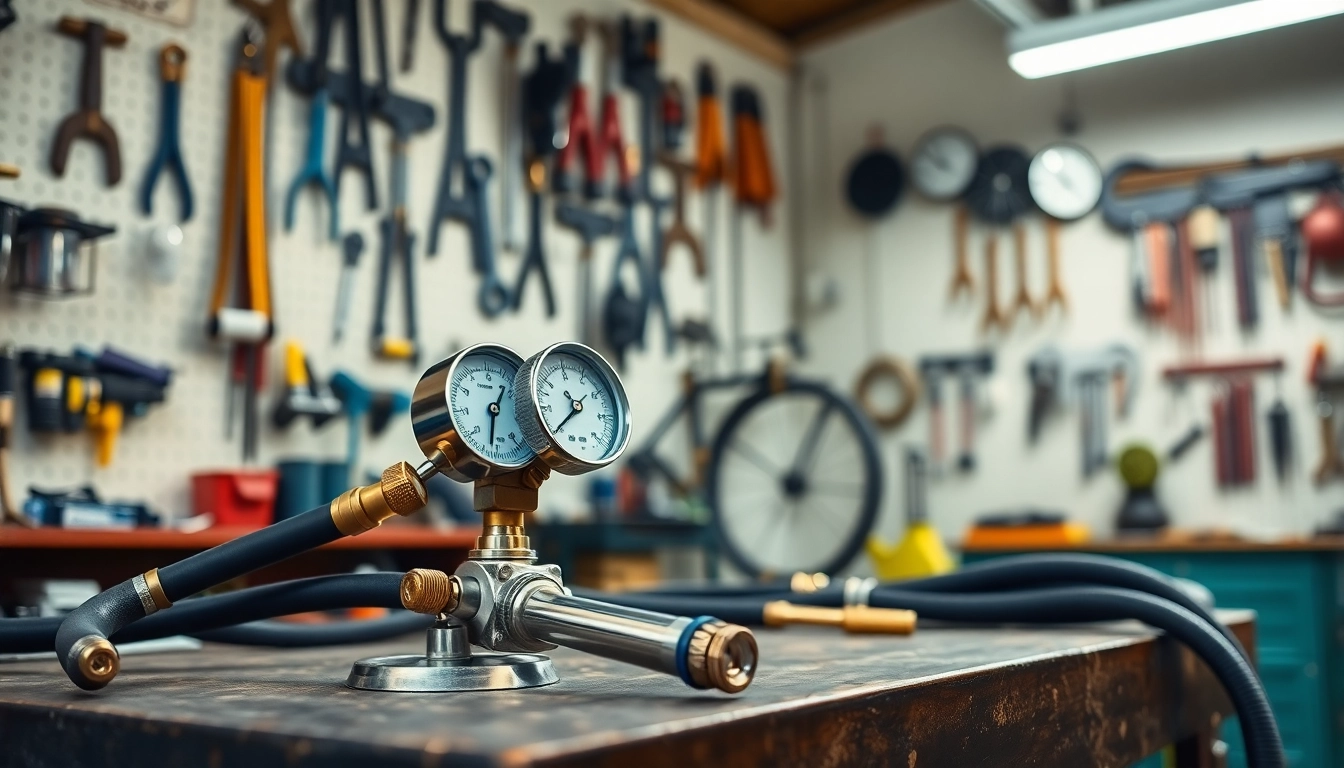For those immersed in the world of fabrication and metal working, mastering the art of welding is paramount. Among the various techniques available, one of the most versatile and widely used is the oxy acetylene welding kit. This kit serves as a comprehensive tool for various welding tasks, suitable for both professionals and DIY enthusiasts. In this article, we will explore the essential elements of an oxy acetylene welding kit, delve into its benefits, guide you through purchasing decisions, outline safety protocols, and provide maintenance tips for optimal performance.
Understanding the Oxy Acetylene Welding Kit
What is an Oxy Acetylene Welding Kit?
An oxy acetylene welding kit is a set of tools that utilize a mixture of oxygen and acetylene gas to produce a high-temperature flame. This flame is used for cutting, welding, brazing, and heating metals. The system’s design includes gas cylinders for both gases, a regulator to control gas flow, hoses to convey the gases to a torch, and the torch itself, where the gases mix and ignite. This setup enables welders to perform various tasks, from simple repair jobs to complex metal fabrication, with precision and efficiency.
Key Components of an Oxy Acetylene Welding Kit
Understanding the individual parts of an oxy acetylene welding kit is crucial for optimal usage. The primary components include:
- Oxygen Cylinder: A pressurized cylinder that holds oxygen as a gas, which enhances combustion.
- Acetylene Cylinder: This cylinder contains acetylene gas, which is highly flammable and provides the heat needed for welding.
- Regulators: These devices control the pressure and flow of gases from the cylinders to the torch.
- Hoses: Typically color-coded (green for oxygen and red for acetylene), these hoses transport gases to the torch.
- Torch: The tool where the gases mix and ignite; it allows the user to control the flame’s heat and size.
- Welding Tips: Interchangeable tips that determine the flame’s characteristics based on the thickness of the metal being worked on.
- Safety Gear: Protective equipment, including goggles and gloves, is essential to ensure the welder’s safety.
Common Uses and Applications of Oxy Acetylene Welding
The versatility of an oxy acetylene welding kit allows it to be employed in various applications, such as:
- General Welding: Suitable for welding various metals, including steel, aluminum, and copper.
- Cutting: The high heat of the flame can easily cut through thick metals.
- Brazing: A process used for joining two metals together without melting the base metal.
- Heating: Used for bending metals or to prepare them for further welding.
- Repair Work: Essential in automotive, construction, and maintenance sectors for repairing metal parts.
Benefits of Using an Oxy Acetylene Welding Kit
Versatility for Different Welding Projects
One of the most significant advantages of an oxy acetylene welding kit is its versatility. This equipment allows for welding, cutting, and brazing across various metals, making it an all-in-one solution for many tasks. Whether you are working on large structural projects or small household jobs, this kit can adapt to your needs, providing flexibility that other welding methods may not offer.
Efficiency in Heating and Cutting Metal
The high temperatures generated by the oxy acetylene flame can exceed 3,500 degrees Fahrenheit (about 1,927 degrees Celsius). This intense heat allows for quick melting of metal, resulting in less time spent on each task. Additionally, the ability to control the flame size enhances efficiency during cutting, allowing for cleaner cuts and reduced material waste. This efficiency is particularly beneficial in industrial applications where time management is critical.
Cost-Effectiveness for DIY and Professional Use
Compared to other welding methods, such as MIG or TIG welding, oxy acetylene kits are often more affordable, both in terms of initial equipment costs and the price of gases. Many welders find that they can complete various projects without the need for multiple specialized machines. This cost-effectiveness makes oxy acetylene welding kits an attractive option for hobbyists and professionals alike, offering excellent value for performance.
Choosing the Right Oxy Acetylene Welding Kit
Factors to Consider When Selecting a Kit
When selecting an oxy acetylene welding kit, various factors should be considered to ensure that you purchase a kit that meets your specific needs:
- Size and Capacity: Ensure the cylinders are appropriately sized for your projects—choose larger cylinders for extended use and smaller ones for portability.
- Quality: Research brand reputation and read reviews to select durable and reliable components.
- Included Accessories: Some kits come with additional accessories, including welding tips and safety gear, which can significantly enhance the value.
- Ease of Use: Particularly for beginners, ensure the kit is user-friendly with clear instructions.
Recommended Brands and Models
Several reputable brands manufacture oxy acetylene welding kits. A few noteworthy options include:
- Unimig: Known for high-quality and reliable equipment, suitable for both professionals and beginners.
- Victor: Offers a range of welded torch kits known for precision and performance.
- Harris: Well-regarded in the industry for durability and effective design.
- Lincoln Electric: Although primarily known for electric welding machines, they also offer excellent oxy acetylene kits.
Comparing Prices and Features
Prices for oxy acetylene welding kits can vary significantly based on features and brand reputation. Generally, complete kits start at around $100 and can exceed $1,000 for industrial-grade systems. When comparing prices, consider the included accessories, warranty options, and the gas consumption rates. It’s essential to balance cost with quality to ensure a worthwhile investment.
Safety Tips for Using Oxy Acetylene Welding Kits
Essential Safety Gear for Welders
Safety should never be compromised while welding. Essential safety gear includes:
- Welding Goggles or Helmets: Protect your eyes from harmful light and flying debris.
- Gloves: Heavy-duty gloves will protect your hands from heat and spatter.
- Protective Clothing: Wear flame-resistant clothing to safeguard against burns.
- Respiratory Protection: Depending on the environment, you may need masks or respirators to avoid inhaling toxic fumes.
Proper Handling and Storage of Gases
Managing gases safely is critical when using an oxy acetylene kit:
- Always store cylinders upright in a well-ventilated area, away from direct sunlight and extreme temperatures.
- Use protective caps on cylinders when not in use to prevent the valves from damage.
- Check for leaks before use by applying a mixture of soap and water on connection points; bubbles will indicate a leak.
Recognizing Hazards and Mitigation Strategies
Be proactive in identifying potential hazards associated with oxy acetylene welding:
- Fire Hazards: Ensure that flammable materials are removed from the work area. Have a fire extinguisher readily available.
- Fume Exposure: Work in well-ventilated areas to minimize exposure to harmful fumes emitted during welding.
- Equipment Failure: Regularly inspect your equipment for wear and tear and replace any suspicious components immediately.
Maintaining Your Oxy Acetylene Welding Kit
Routine Maintenance Practices
To ensure your oxy acetylene welding kit operates at its best, regular maintenance is essential. Here are key practices to follow:
- Inspect hoses for cracks or leaks and replace them if damaged.
- Keep the torch clean and free of debris. Regularly check and replace worn or damaged tips.
- Ensure that the regulators are calibrated and functioning correctly, adjusting as needed based on performance.
Troubleshooting Common Issues
Even the best-equipped welders encounter issues. Here are common problems and solutions:
- Uneven Flame: Check for gas supply issues or blockage in the torch; clean or replace affected parts as necessary.
- Inconsistent Pressure: Inspect the regulators and hoses for leaks; ensure they are securely connected.
- Flame Going Out: Ensure correct settings on the torch and check for gas availability in the cylinders.
When to Replace Components
Knowing when to replace components of your oxy acetylene welding kit can save time and ensure safety:
- Regularly replace hoses every 5-10 years, or sooner if signs of wear appear.
- Replace regulators if you notice signs of corrosion, mechanical damage, or inconsistent pressure.
- Torch tips should be replaced when they start causing irregular flames or are blocked.



